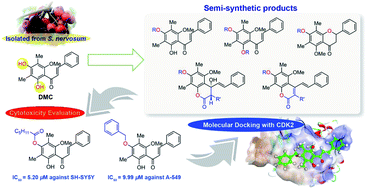Synthesis, cytotoxicity evaluation and molecular docking studies on 2′,4′-dihydroxy-6′-methoxy-3′,5′-dimethylchalcone derivatives†
Abstract
2′,4′-Dihydroxy-6′-methoxy-3′,5′-dimethylchalcone (DMC, 1) was isolated from seeds of Syzygium nervosum A.Cunn. ex DC. exhibiting intriguing biological activities. Herein, thirty three DMC derivatives including 4′-O-monosubstituted-DMC (2), 7-O-acylated-4-hydroxycoumarin derivatives (3), stilbene–coumarin derivatives (4), 2′,4′-disubstituted-DMC (5), and flavanone derivatives (6), were synthesised through acylation, alkylations, and sulfonylation. These semi-synthetic DMC derivatives were evaluated for in vitro cytotoxicity against six carcinoma cell lines. It was found that most derivatives exhibited higher cytotoxicity than DMC. In particular, 4′-O-caproylated-DMC (2b) and 4′-O-methylated-DMC (2g) displayed the strongest cytotoxicity against SH-SY5Y with IC50 values of 5.20 and 7.52 μM, respectively. Additionally, 4′-O-benzylated-DMC (2h) demonstrated the strongest cytotoxicity against A-549 and FaDu with IC50 values of 9.99 and 13.98 μM, respectively. Our structure–activity relationship (SAR) highlights the importance of 2′-OH and the derivatisation pattern of 4′-OH. Furthermore, molecular docking simulation studies shed further light on how these bioactive compounds interact with cyclin-dependent kinase 2 (CDK2).



 Please wait while we load your content...
Please wait while we load your content...